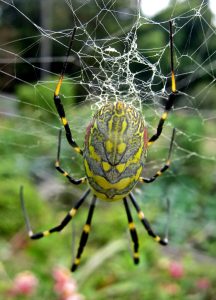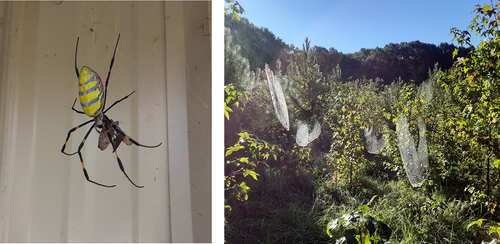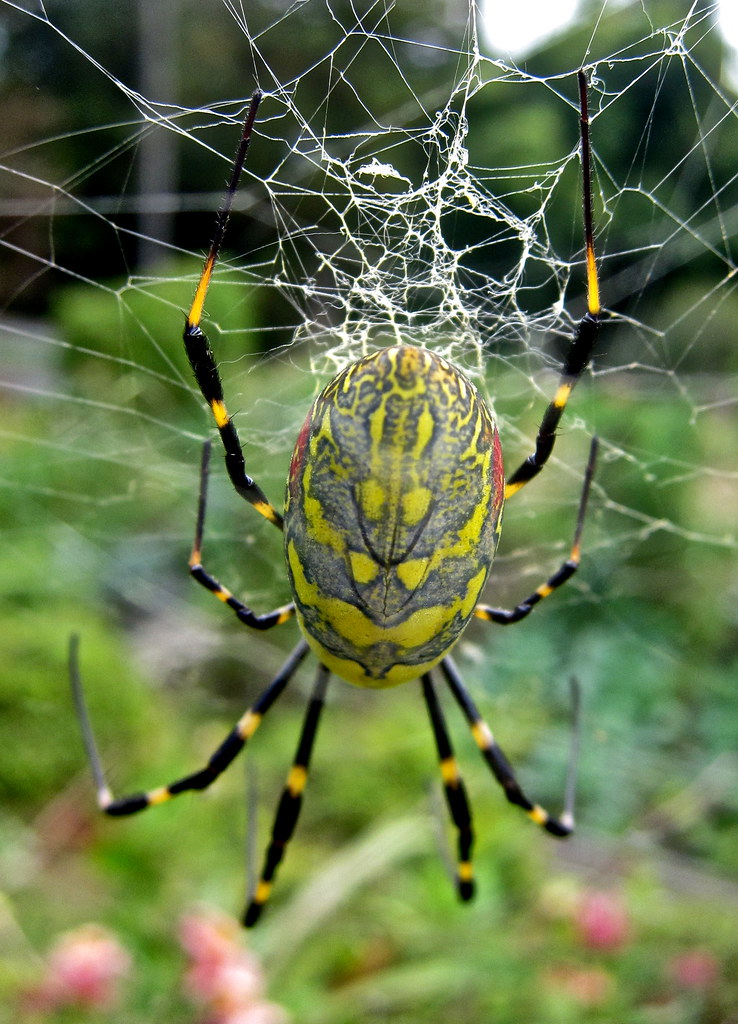OMG. The scientists are looking into this palm-sized beast. Joro spiders are native to Japan and likely made their way to the U.S. in shipping containers.

A joro spider can grow to be about 3 inches long, including a large bulbous body with bright yellow stripes. Its underbelly has distinctive red markings, and it weaves large webs that look as if they’re spun from golden silk.
It gets its name from Jorōgumo, which in Japanese folklore that can turn itself into a beautiful woman to prey on unsuspecting men.
Here’s the Abstract from the scientific paper where they compare two closely related species, one of which is remaining in the south-east of America, one which COULD be on the move north.
A newly-invasive spider from east Asia, Trichonephila clavata, or “jorō spider”, is spreading in the southeastern United States. Little is known about the biology or physiology of this species in this new range. Interestingly, a closely-related species in the same genus, the “golden silk spider,” Trichonephila clavipes, is already successfully established in this same region over the last 160 years. The golden silk spider, which is native to the tropics, has not expanded its range beyond the southeast, likely because of thermal limitations.

This investigation is to determine how the biology and physiology of T. clavatacompare to T. clavipes. We reason that if their physiologies are similar, then T. clavata would be similarly confined to the southeast. We examine online records submitted to iNaturalist.org to compare seasonal distributions and timing, and we collect females to measure physiological traits that help predict environmental tolerance, including metabolic rates, cardiac functioning (heart rate) during cold-exposure, and survival during brief (2 min) below-freezing temperature.
Results show the jorō spider has a shorter season than its cousin, indicating it can complete its lifecycle within a narrow period of suitable weather. It has an inherently higher metabolism (twice as high), and has a 77% higher heart rate when exposed to low temperature. Finally, jorō spiders survive better (74% compared to 50%) in a brief freeze.
These findings suggest the jorō spider can exist in a colder climatic region than the southeastern USA, which can be useful information for management or planning purposes.
It likes the cold
While we should not draw sweeping conclusions from this comparison of just two species (Garland & Adolph, 1994), it is at least clear that the jorō spider has a physiology that is more suited to a cooler environment than its congener, which we know is limited to the southeastern USA.
Our own freeze-trials alone indicate the golden silk spider cannot withstand even brief freezes, while the jorō can. Moreover, while we have no way of knowing if and how far the jorō spider range will expand, it is noteworthy that the native range of T. clavata in eastern Asia (https://www.inaturalist.org/taxa/904334-Trichonephila-clavata) extends from latitudes 30° to 45°N, which overlaps the latitudes of most of the United States.
It is also noteworthy that the climate of Japan is not entirely dissimilar to that of the United States. According to the Japan Meteorological Agency, the climate south of Tokyo is typically warm and mild, with weather resembling that of the southeast United States, while weather in northern Japan is comparable to that of New England (Japan Meteorological Agency, 2022).
Future monitoring, by scientists and citizens, of the range spread of the jorō spider in the USA will confirm whether this climate similarity will result in similar range expansion.
Good news about its fangs
They’re so small they’d probably break trying to bite our skin. Birds seem to like to eat them. Maybe we can learn to live with them!
